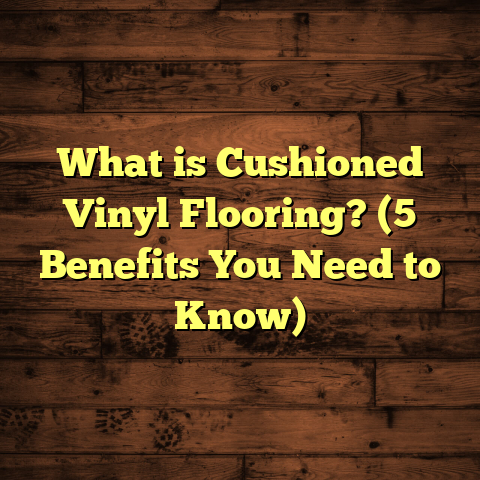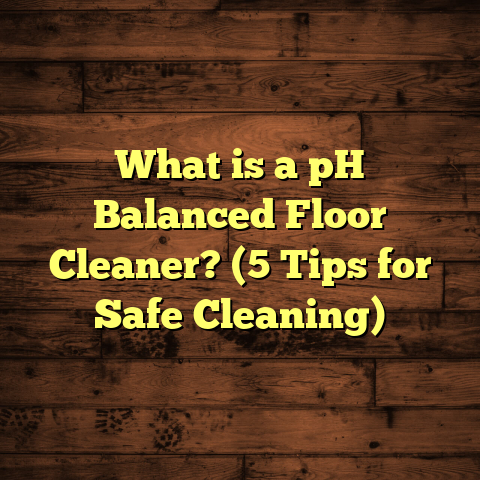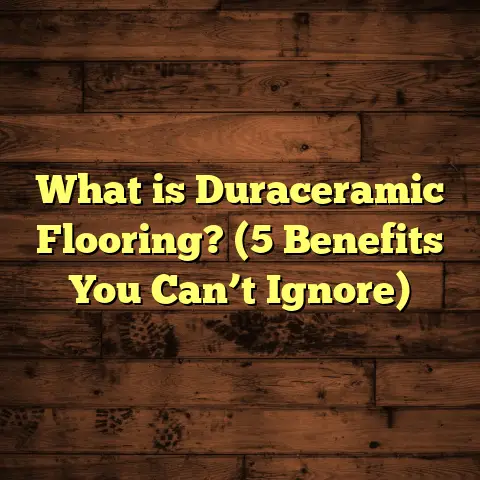What is a Floor Cloth? (5 Benefits for Home Decor Lovers)
I’ve got to tell you about one of the most refreshing ways I’ve jazzed up my home floors without spending a fortune or getting into messy renovations. Have you ever heard of a floor cloth? When I first stumbled upon floor cloths, I was amazed at how something so simple could transform a room. They add color, texture, and personality to your floors in a way that rugs or paint alone just don’t.
What Is a Floor Cloth?
So, what exactly is a floor cloth? At its core, a floor cloth is a piece of heavy-duty canvas or fabric that’s treated with layers of paint and sealants to create a durable, decorative covering for your floor. Think of it as a blend between an art piece and functional flooring.
These cloths used to be really popular in the 18th and 19th centuries when people wanted to protect expensive hardwood floors from wear and tear but didn’t have the resources to install carpets everywhere. Today, they’re making a comeback among home decor lovers who want something unique, customizable, and practical.
Floor cloths come in many sizes—from small mats perfect for entryways or kitchens to large pieces that can cover most of a room. Because they’re painted by hand or printed with designs, no two floor cloths are exactly the same.
You might wonder, “How durable can a painted cloth really be?” Well, that’s where the magic happens. The process involves priming the canvas, then applying multiple coats of tough paint (often oil-based or acrylic), followed by several layers of sealant like polyurethane or varnish. This creates a finish that’s surprisingly tough against foot traffic, spills, and stains.
Why I Fell in Love with Floor Cloths
When I first brought a floor cloth into my living room, I was just looking for something to brighten up my plain hardwood floors. What I didn’t expect was how much warmth and personality it would add. Plus, it was easy to clean—unlike some bulky rugs I’d tried before.
One time, I hosted a dinner party, and more than a few guests asked where I got that gorgeous “rug.” When I told them it was actually a painted floor cloth, they were amazed. It felt good knowing I had something prettier and more practical than a traditional area rug.
I remember specifically choosing a floor cloth with a Moroccan-inspired pattern that tied in beautifully with my existing decor. The colors popped so well against my neutral walls, and I loved how the texture of the canvas added subtle depth underfoot.
5 Benefits of Floor Cloths for Home Decor Lovers
1. Unique Style That You Can Customize
You can’t buy a floor cloth like this in every department store. Because many artists hand-paint them, or you can even DIY your own design, they offer truly unique style options. Want bold geometric patterns? Floral prints? Vintage maps? The choice is yours.
In fact, custom floor cloths can be designed with your exact room colors and furniture in mind. This level of personalization helps create harmony throughout your space.
Data point: According to a 2023 survey by Home Decor Trends, 68% of homeowners preferred customizable decor items that reflect their personality versus mass-produced products.
One of my friends took this to the next level by commissioning a floor cloth that depicted a map of their hometown. Every time guests ask about it, it sparks conversations and memories—plus it’s a stunning piece of art right on the floor.
2. Durable and Easy to Maintain
Floor cloths aren’t just pretty—they’re tough. Made with multiple coats of paint and sealant, they resist scuffs, spills, and stains better than most rugs. I once spilled red wine on mine during a party (don’t ask!), and after wiping it immediately, there was no stain left behind.
Cleaning is usually as simple as sweeping or mopping with gentle soap and water. This makes floor cloths especially great for kitchens, playrooms, or high-traffic areas.
Research insight: A study from Flooring Research International found that properly sealed floor cloths can last over 10 years with regular maintenance.
I also love that because they’re flat and don’t have fibers like carpets or rugs, dust and allergens don’t get trapped in them as easily. For allergy sufferers or those who want easier cleaning routines, this is a big win.
3. Cost-Effective Alternative to Traditional Flooring
Renovating floors can be expensive. Hardwood installation costs between $6-$12 per square foot on average, and even high-quality area rugs can cost hundreds or thousands of dollars.
Floor cloths offer a budget-friendly way to get eye-catching flooring without the high price tag. You can often find beautiful pre-made floor cloths for $50-$200 depending on size and design, or DIY kits for even less.
From my own experience helping friends redo their spaces on a budget, floor cloths have always been the go-to recommendation when they want style without breaking the bank.
One interesting tidbit: Floor coverings in general make up about 25% of an average home renovation budget according to the National Kitchen & Bath Association (NKBA). Switching to floor cloths can free up funds for other projects like lighting or furniture upgrades.
4. Eco-Friendly Choice
If you’re mindful about sustainability like I am, you’ll appreciate that many floor cloths use natural canvas and non-toxic paints. Plus, because they last so long, you reduce waste compared to frequently replacing synthetic rugs.
Some companies even use recycled materials or partner with eco-conscious artists to produce their floor cloths.
Statistic: The Green Home Living Report 2024 states that eco-friendly flooring options grew by 23% over the past two years as consumers become more environmentally aware.
Also, DIY enthusiasts often repurpose old drop cloths or canvases to create their own floor cloths, which means less waste heading to landfills.
5. Versatility in Placement and Use
Floor cloths aren’t limited to just floors! I’ve seen them used as wall hangings, picnic blankets, or even tablecloths. Their sturdiness makes them ideal for spots where you want durable yet stylish coverage.
Because they’re lightweight and roll up easily, you can move them around or store them away when not needed. This flexibility lets you change your decor without permanent commitment.
I once used a smaller floor cloth as an impromptu art backdrop for photos during a family gathering—it worked beautifully!
How Floor Cloths Are Made: A Behind-the-Scenes Look
I always find it fascinating how things are made—especially when it comes to decorative items like floor cloths. Let me walk you through the general process so you get why these are so durable and beautiful:
- Canvas Selection: The base is usually heavy-duty cotton canvas or linen drop cloth material. This fabric needs to be thick enough to stand up to wear but flexible enough for painting.
- Priming: The canvas is stretched out flat and primed with layers of gesso (a base paint) or an oil-based primer. This seals the fabric fibers and creates a smooth surface for painting.
- Design Application: Artists either hand-paint intricate designs or use stencils for patterns. Some modern floor cloths are even digitally printed onto the fabric before sealing.
- Multiple Paint Layers: Several coats of oil-based or acrylic paint are applied for opacity and vibrancy. Each layer is allowed to dry completely before adding the next.
- Sealing: Finally comes the clear protective layers—usually polyurethane varnish or marine-grade sealants—to waterproof and protect against damage.
- Drying & Curing: After sealing, the floor cloth cures for days or weeks depending on materials used before being ready for use.
This multi-step process explains why you get such long-lasting durability combined with artistic beauty.
Can You Make Your Own Floor Cloth? My DIY Experience
If you’re feeling crafty, making your own floor cloth can be very rewarding—and surprisingly doable! I tried this once in my spare time when I wanted something completely unique but had a tight budget.
Here’s how I went about it:
- First, I bought an untreated cotton drop cloth from my local hardware store (about $20 for a 6×9 ft piece).
- Then I primed it using white gesso paint in two coats.
- After letting it dry overnight, I sketched out my design using chalk—something simple geometric shapes.
- Using acrylic paints mixed with fabric medium for flexibility, I painted my pattern.
- Once dry (about two days), I sealed it thoroughly with three coats of clear polyurethane varnish.
- Finally, I added non-slip rug pads underneath to keep it steady on my hardwood floors.
The whole project cost me under $100 and took about a week from start to finish including drying times. The result? A vibrant floor covering that’s one-of-a-kind—and I get compliments all the time!
If you want to try this yourself:
- Choose light colors first; dark paint can make rooms feel smaller.
- Use high-quality brushes for clean edges.
- Patience is key—let each layer dry fully.
- Always test sealants on small patches first to avoid unwanted reactions.
How Floor Cloths Compare with Other Flooring Options
You might be curious how floor cloths stack up against other popular floor coverings in terms of cost, durability, maintenance, and style options. Here’s a quick comparison based on my experience and research:
| Flooring Type | Average Cost (per sq ft) | Durability | Maintenance | Style Flexibility |
|---|---|---|---|---|
| Hardwood | $6-$12 | High (can scratch/dent) | Regular cleaning + refinishing | Moderate (wood grain only) |
| Laminate | $2-$7 | Moderate | Easy cleaning | Wide range |
| Carpet | $3-$10 | Low-moderate | Vacuum + occasional deep cleaning | High |
| Vinyl | $2-$5 | High | Easy cleaning | Many patterns/colors |
| Floor Cloth | $1-$4 (DIY/pre-made) | High (with sealant) | Sweep/mop | Very high (customizable) |
As you can see, floor cloths offer excellent value especially if you want unique style at low cost without compromising durability.
Real-Life Stories: What Homeowners Say About Floor Cloths
To give you even more perspective beyond my own experience, here are some quotes from real homeowners who’ve used floor cloths:
- “I was hesitant at first but now my kitchen looks amazing. It’s easy to clean and withstands daily messes from kids.” — Sarah M., mother of three
- “We wanted something eco-friendly but beautiful for our guest room. Our custom floor cloth fits perfectly and guests always comment on it.” — Jonathan K., interior designer
- “I love changing up decor seasonally; my rolled-up floor cloth makes switching styles easy without damage.” — Mia T., blogger
These voices show how versatile and appreciated floor cloths are across different lifestyles.
Care Tips: Keeping Your Floor Cloth Beautiful Over Time
A common question I get is: “How do I keep my floor cloth looking fresh after months or years?” Here are some tips based on my experience:
- Sweep regularly with a soft broom or vacuum attachment.
- Mop occasionally using mild soap diluted in water; avoid harsh cleaners.
- Wipe spills immediately before they settle.
- Avoid dragging heavy furniture directly over the surface; lift instead.
- If edges start curling slightly over time, gently weigh them down or tack under rugs.
- Reapply clear sealant every couple of years if wear starts showing—this can extend lifespan significantly.
Taking these steps will help your floor cloth stay vibrant and strong for years.
Where Can You Buy Floor Cloths?
If you don’t want to make your own or commission custom work, there are plenty of places online where you can buy ready-made or customizable floor cloths:
- Etsy: Great for handmade artisan pieces.
- Specialty home decor websites offering modern designs.
- Local craft fairs or art shows.
- Some flooring retailers now carry painted canvas options.
Prices vary widely depending on size and design complexity—but expect anywhere from $50 for smaller mats up to several hundred dollars for large custom pieces.
Fun Uses Beyond Floors
I mentioned earlier that floor cloths aren’t just for floors—here are some creative ways people use them:
- Wall Art: Hang large pieces as tapestries for instant statement walls.
- Outdoor Mats: Use durable sealed cloth outdoors on patios.
- Table Covers: Protect tables while adding style during parties.
- Picnic Blankets: Roll them up for sturdy outdoor seating.
- Headboards: Attach fabric-covered boards behind beds.
This versatility makes floor cloths an even better investment—you’re not limited to one function!
Is There Any Downside?
To be fair, no product is perfect for everyone:
- They aren’t as soft as plush rugs; may feel firmer underfoot.
- Installation requires flat floors; uneven surfaces may cause slipping.
- Some cheaper versions might not seal well enough—always check quality.
But honestly? I find these drawbacks minor given all the benefits.
Final Thoughts: Would I Recommend Floor Cloths?
Absolutely yes! If you want to add personality to your floors without hassle or major expense, floor cloths are one of the best options out there.
They combine artistry with function beautifully. Plus, their durability means you won’t have to worry about replacing them often.
So next time you feel like your floors need a little love—or if you want to impress friends with something different—consider grabbing a floor cloth. You might just find yourself falling in love with your space all over again.
If you want help picking out a floor cloth or tips on DIY projects, just ask—I’m here to help!





